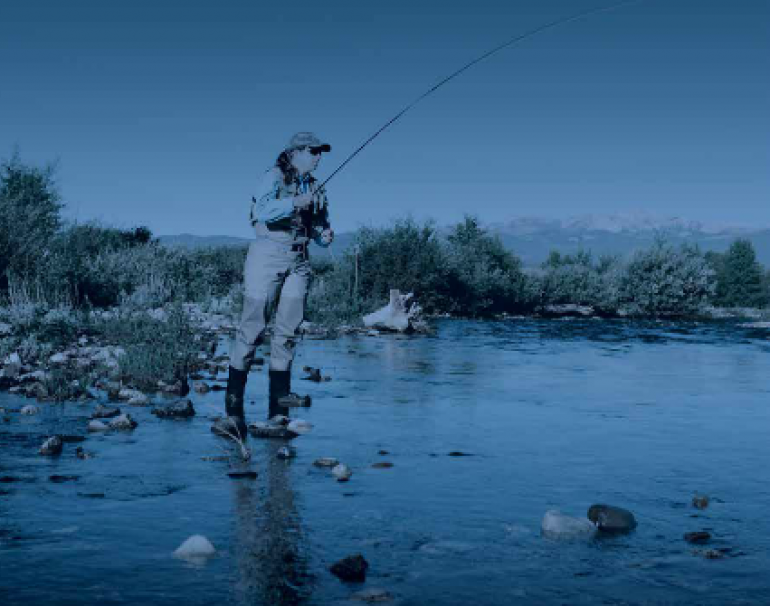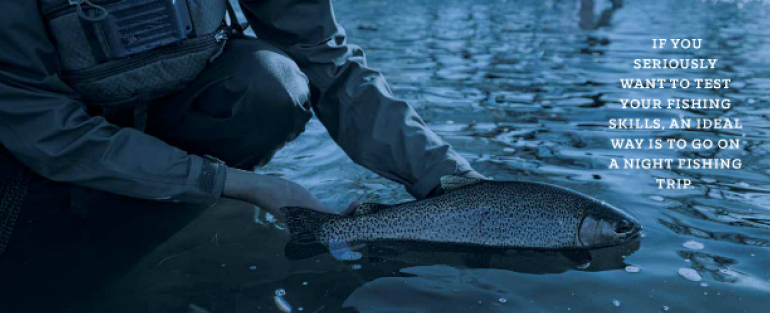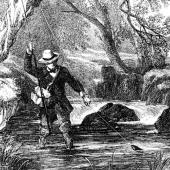Night Fly-Fishing in Montana
Night Fishing Tips & Tricks
Are you tired of sweating through days on your favorite Montana lake, river, or stream while fending off recreational boaters and other anglers who compete with you for the same choice fishing spots?
If so, night fly-fishing could be just the ticket for you. An excellent reason to try fishing at night is the increased chance of catching a good size fish on a fly.
Granted, night fishing is somewhat more difficult to do than fishing when the sun is shining. However, the practice is becoming increasingly popular.
In hot weather during the day, fish go deep in order to find more oxygen, making them somewhat difficult to catch. At night, fish rise in the water, making them more accessible.
With a few pointers, you can make your nocturnal outings enjoyable and productive.
• Start with a body of water that you know well. The lake or river on which you choose to fish will affect your success at night and can also be a factor in your safety. Because you have fished it many times in the past, you will be aware of natural or man-made obstacles.
• Make sure that this body of water routinely yields fish.
If you can catch a large mouth bass at high noon on your favorite lake, you can likely catch one around midnight at or near the same place. Heavily fished lakes during the day are excellent nighttime fishing spots. Although a huge influx of anglers may turn fish off during the day, those same fish will be more prone to actively feed once the sun goes down, giving you access to heretofore untapped angling possibilities.
• Choose a lake or river that has access points to the areas you intend to fish. Launch ramps with only a short run are best, especially for the ease and safety they provide. Clear water is preferred over dirty or stained, as it will increase the likelihood of fish locating your fly. Weather conditions often play an important role in your fishing success. The most productive nights often occur after a sunny day.
• Stock your fly tackle box with big, bold patterns. When fishing a fast-moving section of water, you need flies that are both heavy and flashy. Should you decide to fish slow-moving water, you will need large, bushy flies in your angling arsenal.
• Get the moon to help you. The moon is such an important player when night fishing, you’ll wonder why you never thought of the earth’s natural satellite earlier as a fishing ally. But be advised: the night atmosphere is so different, the pattern of light and shadows so varied, you may lose your bearings in the moonlight. Thankfully, the brilliance of a full moon lights up calm waters so that you can often spot fish in the shadows in the water. On bright moonlit nights, pick fishing spots where shadows are dense. On other nights, sidle up to your favorite nighttime spot and cast a fly. What happens then may exceed your expectations.

WHAT YOU'LL NEED
• Light sources are important when night fishing. Many anglers use “black lights” and fluorescent line. A black light produces scant visible light but considerable ultraviolet light. The radiation emitted by a black light will make anything with fluorescent material in it glow brightly.
• Fluorescent line glows when exposed to black lights at night. This is helpful for both tying knots and detecting fish bites. Since black lights produce much less visible light, they shouldn’t spook fish as much as regular lights do.
• A front-mounted light on your boat is a good idea since you want to keep yourself visible to other boaters that may be fishing in your vicinity. Always bring along flashlights. Place one in front of the boat and another near the back.
DO'S AND DONT'S
Do not venture out at night on unfamiliar water for your safety.
• Be familiar with the shoreline surroundings and skyline, so that you can find your way back to the landing from which you departed. It’s easy to get lost on the water at night. The shoreline looks much the same at night and many familiar landmarks that you can see during the daytime appear murky after it gets dark.
• A key aspect of nighttime fly-fishing involves wading quietly. Anytime you set foot in a stream, you show your whereabouts to fish. Splashing into the water hurriedly to get to a spot that you know holds lots of fish will likely drive fish to different holding areas.
• Do everything possible to minimize potential problems. An organized boat is a must. Take along only the minimum tackle you’ll actually need for night fishing. Make a point to put away all rods, reels, tackle and accessories that aren’t being used.
• During the day, when a river is alive with big mayflies being plucked from the surface by aggressive trout, choosing a big coffin fly is likely the way to go. When water is cold and the sun is high and fish are wary, you might choose a heavy nymph to cast just past the nose of a fish.
• In the daytime, fish hunt primarily by sight. At night, however, a fish’s vision takes a back seat to its hearing. Fish most certainly hunt by sight at night as well, but due to little available light, a fish most often hears its prey before it sees it. And so, a Montana angler at night should choose a fly first on how it will be ‘heard’ by a fish. This equates to a fly that moves or “pushes” (displaces) water. The fly should be ‘noisy’ but subtle. Good examples are deer hair heads, collared bucktail, and big woolly buggers.

A WORD ABOUT BASS
Fishing for bass is the most common type of night fishing in Montana. Since bass seldom travel great distances, you should be able to locate them at the same locations they are found during the day. If you have a favorite daytime spot, they should be there at night as well. Bass also seek spots near man-made structures where baitfish swim.
Bass rely primarily on their sense of smell during the night. Your objective, therefore, should be to create a smell of food or wounded prey.
Docks are a great location for finding large mouth bass. Smaller fish are attracted to lighted structures, bringing larger predators in to check out the situation. Work the channels surrounding docks, as they are prime cruising lanes for bass to feed around.
If you seriously want to test your fishing skills, an ideal way is to go on a night fishing trip. The cooler air, lower temperatures, and absence of day traffic will make it an altogether different experience. Many long-time anglers endorse the idea of night fly angling for big fish.
Night fly-fishing is not for the faint of heart. Such activity is only for the most adventurous. If you enjoy undertaking new activities, then by all means give night fly-fishing a try, but remember to always be careful, stay off the sauce when fishing, and clean your fish thoroughly before cooking them.












Leave a Comment Here